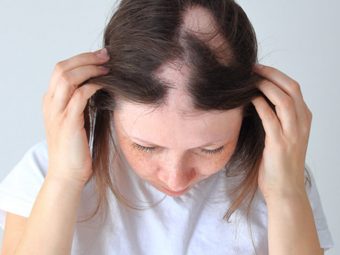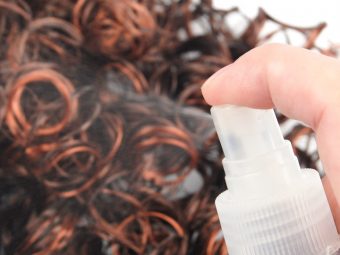Side Effects Of Hair Transplantation You Must Know
This procedure may transform some people's lives, but it does pose its own risks.

Hair transplantation is a medical procedure where active hair follicles are transplanted from one area of the scalp to the bald part (1). It produces natural-looking results and can help treat alopecia (2), (3), (4). However, you must also know about the side effects of hair transplantation (5). Keep reading to know everything about the hair transplant procedure and the risks involved.
In This Article
Hair Transplant How It Works And Types
Hair transplant is a hair restoration surgery done by a seasoned cosmetic surgeon. Active hair follicles from the scalp or any body parts are transplanted to the bald areas of the scalp. The active hair follicles produce the most natural-looking hair in the bald area.
There are two types of hair transplantation Follicular Unit Transplantation (FUT) and Follicular Unit Extraction (FUE) (6):
- Follicular Unit Transplantation (FUT) This procedure involves placing the extracted follicular units in the recipient scalp. This requires precision as the punches for the follicular units need to be placed right. The punches should not be larger than the units.
- Follicular Unit Extraction (FUE) This hair transplant procedure involves extracting the follicular units from the donor site. An area of healthy hair growth is opened, and some follicular units are taken from there. With the help of special micro punches, the units are implanted in the bald area.
It takes almost an hour to remove less than 100 follicular units. With that in mind, let’s now take a look at the side effects of hair transplantation.
Side Effects Of Hair Transplant
- Hair Shedding
Excessive hair shedding is a common side effect of hair transplantation. Due to vascular disruption and surgical trauma, the donor area (where the active hair follicles are extracted) may experience hair thinning. Hair shedding is greater in Follicular Unit Extraction (FUE) than Follicular Unit Transplant (FUT) as the graft is larger. Moreover, FUE causes permanent hair shedding, whereas FUT reverses hair shedding after surgery downtime.
- Bleeding
Whether you get FUE or FUT, there are bound to be cuts. The doctor ensures that bleeding is minimal. However, you may also experience bleeding during the post-operative recovery time.
- Scarring
Scarring or sterile folliculitis is common in some people who undergo hair transplantation. The scars can also make the surgery visible. In a study, 23% of patients were affected with sterile folliculitis after hair restoration surgery (7).
- Inflammation
Lichen planopilaris (LLP) is a rare inflammatory hair disorder and an extreme version of sterile folliculitis. It can even lead to permanent alopecia and replacement of hair follicles with scar-like fibrous tissue (8).
- Infections
Infections may occur near the site of the sutures. Epidermal cysts may also occur, which needs occasional drainage (9). Poor scalp hygiene can lead to localized infections in donor and recipient areas (5).
- Pain
Hair transplantation is an invasive surgery that can cause pain if the anesthesia is not administered in the right dose. During post-operative recovery, you might also feel a stretching sensation.
- Swelling
Swelling or edema is common in people undergoing hair transplantation. You may experience swelling around the eyes and forehead. It can be severe sometimes and make the eye appear darker.
- Itching
The formation of scabs at the site of the transplantation can cause itching. However, the itching of the scalp will stop after the initial days of the surgery.
Note: If you use minoxidil, stop its usage until the area heals.
- Numbness
Numbness may occur due to local anesthesia or if hair transplantation is done by inexperienced hands, leading to nerve damage. When the anesthesia wears off, the numbness reduces.
These are the side effects of hair transplantation. However, do not get all sweaty yet. Consult your doctor before deciding for or against it. What you can do is check if you are an ideal candidate for hair transplantation. Scroll down to know more.
Ideal Candidate For Hair Transplantation
- Age: If you are above 25 years of age, you are probably a good candidate for hair transplantation.
- Hair Caliber/Diameter: If your hair has a larger shaft diameter or thicker caliber, you will get denser coverage through hair transplantation.
- Donor Hair Density: If the donor site has 80 follicle units (FU) per square centimeter, you can opt for hair transplantation.
- Degree Of Baldness: If the baldness is severe, you might not be the ideal candidate for hair transplantation, as only some area can be covered.
- Expectations: If you have realistic expectations of the treatment and are undergoing treatment with minoxidil or other hair growth medicines, you are an ideal candidate for hair transplantation.
There are other effective, partially invasive, and non-invasive methods for growing your hair. Take a look at those hair treatment options below.
Other Hair Growth Treatment Options
- PRP Treatment: Platelet-Rich Plasma treatment is a regenerative method for hair loss. It is a partially invasive hair growth treatment. Platelets from your blood are separated and injected at the balding site to help stimulate the follicles and lead to hair growth.
- Laser Light Treatment: Laser light treatment or Low-Level Laser Therapy (LLLT) is an FDA-approved treatment for male and female pattern hair loss (androgenic alopecia). It is non-invasive and painless. Click here for the benefits, limitations, and costs of this procedure.
Note: Consult a dietitian for a well-balanced diet as a healthy lifestyle is important to help stimulate hair growth and reduce hair fall.
Last but not least, there’s another drawback to hair transplantation. Scroll down to know more.
Hair Transplant Cost
A hair transplant might cost $1500 and above. It also comes with various side effects and requires 3-4 weeks of recovery time. On the other hand, PRP treatment costs around $1500 to $3000, and it has almost no side effects. Laser treatment costs $1600 to $5000, depending on whether you use at-home equipment or visit a clinic.
The side effects of hair transplantation are not very well-known. This procedure is performed by a cosmetic surgeon, and it involves active hair follicles being transplanted from the active area to the bald area. However, side effects like hair shedding, bleeding, scarring, inflammation, infections, pain, swelling, itching, and numbness may occur. Therefore, it is always safe to check whether you are an ideal candidate for a hair transplant. Age, hair quality, degree of baldness, and donor hair density determine the effectiveness of hair transplantation. You can also opt for PRP and or laser light treatment as hair growth treatment options.
Frequently Asked Questions
How long does the hair last after transplant?
After a transplant, the new hairline is visible, and the transplanted hair starts falling after 4-6 weeks.
How long does it take to recover from a hair transplant?
It takes about 3-4 weeks to recover from a hair transplant.
What should not be done after a hair transplant?
Avoid washing your hair for 48 hours after hair transplantation. After 48 hours, use a mild shampoo and be gentle while massaging the scalp. Do not dye your hair or sleep on the side of the transplant. Avoid wearing helmets and caps. Do not sit under the sun or apply ice directly on the hair transplantation site.
Which is better – FUE or FUT hair transplant?
FUE leads to more hair shedding than FUT post hair transplantation surgery. Let your doctor decide which method would suit you the best.
Key Takeaways
- In a hair transplant, active hair follicles are taken from the body or scalp and placed in the bald area.
- There are two main types of hair transplants: follicular unit extractions and follicular unit transplantation.
- Hair transplants may cause side effects, such as hair shedding, scarring, inflammation, infections, and swelling.
References:
Articles on StyleCraze are backed by verified information from peer-reviewed and academic research papers, reputed organizations, research institutions, and medical associations to ensure accuracy and relevance. Read our editorial policy to learn more.
- A HAIR TRANSPLANT CAN GIVE YOU PERMANENT, NATURAL-LOOKING RESULTS
https://www.aad.org/public/diseases/hair-loss/treatment/transplant - Female hair restoration
https://pubmed.ncbi.nlm.nih.gov/24017982/ - A Systematic Review of the Outcome of Hair Transplantation in Primary Scarring Alopecia
https://pubmed.ncbi.nlm.nih.gov/30815438/ - Hair transplantation surgery
https://www.ncbi.nlm.nih.gov/pmc/articles/PMC2825128/ - Complications in Hair Transplantation
https://www.ncbi.nlm.nih.gov/pmc/articles/PMC6371733/ - Hair Transplantation
https://www.ncbi.nlm.nih.gov/books/NBK547740/ - Complications of Hair Restoration Surgery: A Retrospective Analysis
https://www.ncbi.nlm.nih.gov/pmc/articles/PMC4212293/ - Lichen planopilaris following hair transplantation and face-lift surgery
https://pubmed.ncbi.nlm.nih.gov/21985326/ - Hair transplantation surgery
https://www.ncbi.nlm.nih.gov/pmc/articles/PMC2825128/
- A HAIR TRANSPLANT CAN GIVE YOU PERMANENT, NATURAL-LOOKING RESULTS













